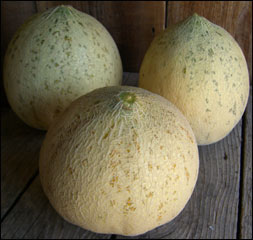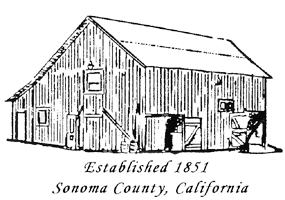Sonoma
County Farm Bureau - Article
written in Sonoma-Marin Farm News, September 2007
crane melons are farming legacy
for the crane family of santa rosa

Jennifer Crane looks over the patch of Santa Rosa ground
farmed by Crane ancestors for the last 155 years and makes
the sad assessment that this year’s crop of Crane melons
is late and in short supply.
“ The season for Crane melons will be short and sweet
this year. There wasn’t enough spring rain to provide
the moisture the vines needed to produce a bountiful crop,” said
Crane, 28, the sixth generation of her family to farm the
Santa Rosa land settled by Crane family members in 1852.
The land has produced everything from oats to sheep, with
Crane melons being a farming mainstay since they were developed
in the 1920’s by Jennifer’s great, great grandfather
Oliver Crane, a homespun plant breeder.
Crane expects her first Crane melons to be harvested in
the second week of September, with the season lasting until
the last precious melon is picked or the first frost hits.
When the season’s first melons roll out of the fields, the Cranes will
open their landmark Crane Melon Barn on Petaluma Hill Road where customers
flock to get the original Crane melons. Each fall the historic barn, built
in 1868, becomes a bustling trading post for Crane melons, a uniquely Sonoma
County fruit enjoyed by local residents for more than 80 years.
The delectable, soccer-ball-sized Crane melon was developed
when Oliver Crane crossed a Japanese melon and a California
cantaloupe, creating a new melon that is more flavorful than
either parent. Each year, Oliver Crane selected the biggest
and best melons for next year’s seeds, genetically
selecting for melons that flourished in the family’s
adobe soil along Petaluma Hill and Crane Canyon roads.
Other growers produce Crane Melons too, but the Cranes consider
these melons inferior imposters. The Crane melon was developed
by my great, great grandfather, Oliver Crane, to be grown
on his property in the adobe soil and dry farmed. This ranch
has the climate and soil conditions where the Crane melon,
through genetic selection, attains its untimate flavor and
texture," said Jennifer Crane, who started working in
the Crane Melon Barn when she was four years old. A wine
grape grower too, Crane said what makes their Crane melons
so much better is the terroir, a French term for the special
combination of soil, climate and farming techniques that
allow a food crop, whether wine grapes or Crane melons, to
acheive their ultimate flavors.
Crane fumes when she encounters what she considers fake
Crane melons. “ I can spot a melon a mile away that
wasn’t grown here on the Crane Ranch. They don’t
look or taste anything like a true Crane melon,” said
Crane. “It’s frustrating when people raise and
market melons under our name.”
Crane melon had become the generic name of the melon developed
by the Crane family. The legal ruling cleared the way for
melons not grown by Crane family members to be called a Crane
melon. So, increasingly farm stands and grocery stores are
selling Crane melons raised by other growers.
Jennifer Crane compares a true Crane melon, grown by Cranes
on Crane land, to an authentic Louis Vuitton handbag, which
faces competition from cheap knock-offs.
“It’s a matter of quality and getting the real thing,” said
Crane.
|
Melon
season is a busy time for the Cranes but they have friends
and family who
pitch and help. Jennifer Crane, who
went to college in London, has a circle of close friends
who live around the world but come to help during the melon
season. It’s a pleasant break from their fast-paced
urbane lives in big cities.
“ My friends love coming to Sonoma County and being
part of our farming experience each fall,” said Jennifer
Crane.
Crane’s father, Richard Crane, who learned the secrets of Crane melon
growing from his father, the late George Crane, said he’s seen much bigger-yielding
melon crops in the family’s fields. This year is a disappointment because
it takes as much work to grow a small crop as a big one.
“ We needed that extra eight to nine inches of rain
that we didn’t get this year,” said Richard Crane,
whose mechanical and artistic talents are evident on the
grounds of the Crane Melon Barn. He specializes in a unique
form of garden sculptures fashioned from scrap farm machinery
and implements.
Like their ancestors before
them, Jennifer and Rick Crane produce melons that are dry-farmed,
which means the vines
aren’t irrigated during the growing season. The plants
are watered just enough to get them started in the spring
but then the Cranes depend on the heavy adobe soil to hold
the moisture necessary to get the vines through harvest.
It’s a farming method that works most years. But this
year’s low rainfall didn’t provide the moisture
to sustain a big crop.
The Cranes take the smaller crop in stride, knowing full
well the vagaries of farming and the impact that Mother Nature
has on the size and quality of crops. Like all farmers, they
hope next year will be better.

The Cranes plant 35 acres of
their 142 acre ranch to Crane melons, producing hay on
the remaining farmland. The Cranes
also have planted five acres of pinot noir wine grapes on
the family land, selling grapes from what they call Chester’s
Vineyard to winemaker David Noyes, formerly of Kunde Estate
Winery. The vineyard is named for Jennifer’s cat.
The grapes are a way to diversify
the Crane farming operation so in years like this, when
the melon crop is short, there
will be another source of income. “ It’s important
to have diversity in agriculture,” said Crane. “That
way all of your eggs aren’t in one basket if one crop
fails for some reason.”
Jennifer Crane, the only child
of Richard and Cindy Crane, plans to be farming all of
her life on the family land that
has spanned three centuries under Crane ownership. She is
passionate about carrying on the family’s ranching
tradition on the adobe fields outside Santa Rosa.
“ This land is part of who I am, it’s my legacy,” said
Crane. “I’m not going to be the one to sell the
land after 160 years so I can have a big bank account.”

Sonoma
County Farm Trails -
Member since 1973 |
Article
from SLOWFOOD USA
ark
of taste - crane melon
Richard Hope Crane arrived in California
from Missouri for the Gold Rush in 1849. He had been a farmer
his whole life, like all of his forefathers. He mined gold
for several years before arriving in Sonoma County in 1852.
Oliver Crane, the son of Richard H. Crane, developed the
Crane Melon in the early 1900s by crossing several varieties
of melons, including a Japanese melon, a white melon, a Persian
melon and an ambrosia melon among others.
The Crane melon averages 4-7 pounds, is round like a soccer ball, and has a
light orange flesh that is highly aromatic. The fruit is exceptionally sweet
and juicy. As Jennifer Crane—the sixth generation to own and operate
the Crane Ranch and grow the Crane melon-- explains, “The Crane melon’s
flavor is due to its terroir. The melon was developed to be grown on the land
that’s been in the Crane family for nearly 160 years --in a particular
soil, within a specific climate zone, farmed in a certain style.”
The Crane Melon is almost never found
in conventional stores. The melons do not have the shelf
life for shipping because they are vine ripened. At the Crane
Ranch they are picked ripe daily when in season from September
1 to October 31 (on an average year).
|
melons for the passionate grower
picture of book here
amy goldman (Author)
victor schrager (Photographer)
|

